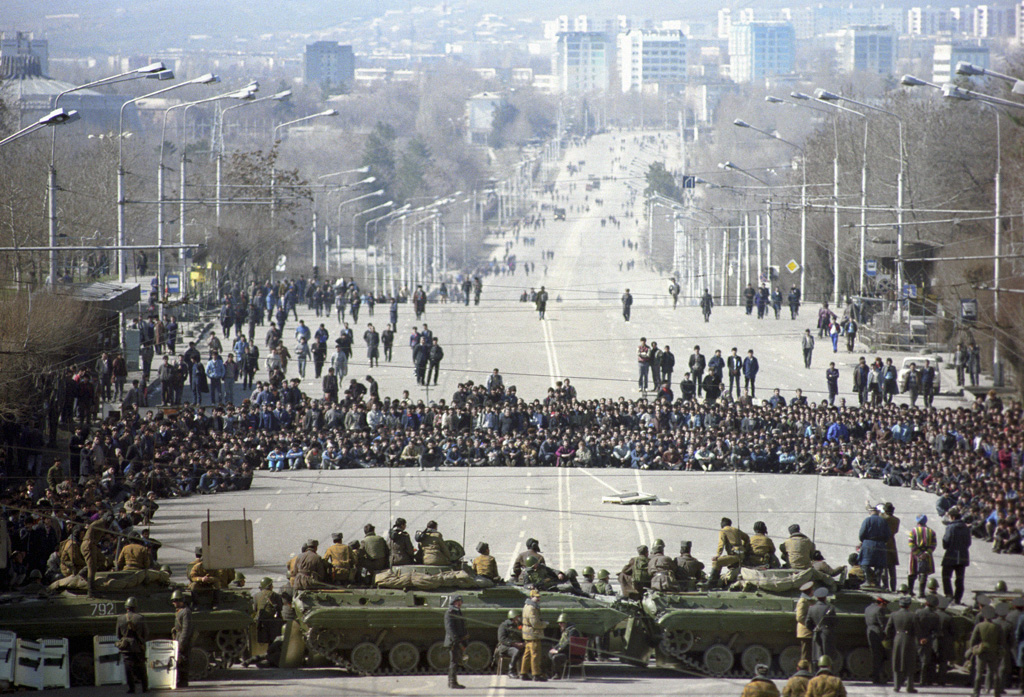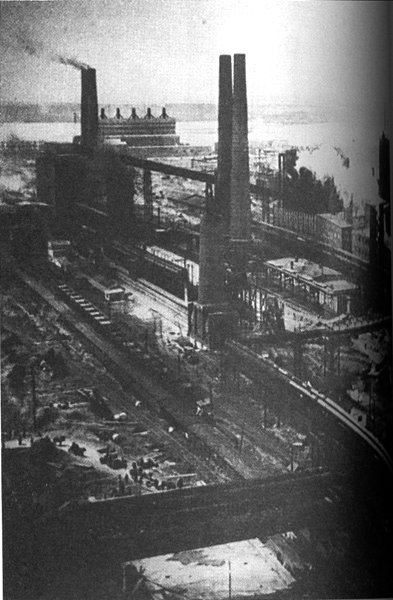|
Mayakovsky Theatre (Dushanbe)
The Mayakovsky Theatre was a historic theatre in Dushanbe, the capital of Tajikistan. It was torn down amid protests in 2016. The edifice was designed by Pyotr Vaulin and built in the 1920s in what was then known as Stalinabad. It was the first building with permanent foundations to be completed in the future capital, and initially served as a farmers' meeting place. The House of Peasants, as it was known, was the venue where Tajik politician Nusratullo Makhsum declared the creation of the Tajik Soviet Socialist Republic in October 1929. The building was by turns the venue of Tajikistan's first cinema, its first modern library, first public reading rooms, first theater, first radio broadcasting center, first driving school and first home to the Pioneers youth movement. In its latter years, it was the home of the city's Mayakovsky theatre company. At the outbreak of the Tajik civil war in the 1990s, the company moved temporarily to Magnitogorsk Magnitogorsk ( rus, Магн� ... [...More Info...] [...Related Items...] OR: [Wikipedia] [Google] [Baidu] |
Dushanbe
Dushanbe ( tg, Душанбе, ; ; russian: Душанбе) is the capital and largest city of Tajikistan. , Dushanbe had a population of 863,400 and that population was largely Tajik. Until 1929, the city was known in Russian as Dyushambe (russian: Дюшамбе, ''Dyushambe''), and from 1929 to 1961 as Stalinabad ( tg, Сталинобод, Stalinobod), after Joseph Stalin. Dushanbe is located in the Gissar Valley, bounded by the Gissar Range in the north and east and the Babatag, Aktau, Rangontau and Karatau mountains in the south, and has an elevation of 750–930 m. The city is divided into four districts, all named after historical figures: Ismail Samani, Avicenna, Ferdowsi, and Shah Mansur. In ancient times, what is now or is close to modern Dushanbe was settled by various empires and peoples, including Mousterian tool-users, various neolithic cultures, the Achaemenid Empire, Greco-Bactria, the Kushan Empire, and the Hephthalites. In the Middle Ages, more settlement ... [...More Info...] [...Related Items...] OR: [Wikipedia] [Google] [Baidu] |
Tajikistan
Tajikistan (, ; tg, Тоҷикистон, Tojikiston; russian: Таджикистан, Tadzhikistan), officially the Republic of Tajikistan ( tg, Ҷумҳурии Тоҷикистон, Jumhurii Tojikiston), is a landlocked country in Central Asia. It has an area of and an estimated population of 9,749,625 people. Its capital and largest city is Dushanbe. It is bordered by Afghanistan to the south, Uzbekistan to the west, Kyrgyzstan to the north, and China to the east. It is separated narrowly from Pakistan by Afghanistan's Wakhan Corridor. The traditional homelands of the Tajiks include present-day Tajikistan as well as parts of Afghanistan and Uzbekistan. The territory that now constitutes Tajikistan was previously home to several ancient cultures, including the city of Sarazm of the Neolithic and the Bronze Age and was later home to kingdoms ruled by people of different faiths and cultures, including the Oxus civilization, Andronovo culture, Buddhism, Nestorian Ch ... [...More Info...] [...Related Items...] OR: [Wikipedia] [Google] [Baidu] |
Stalinabad
Dushanbe ( tg, Душанбе, ; ; russian: Душанбе) is the capital and largest city of Tajikistan. , Dushanbe had a population of 863,400 and that population was largely Tajik. Until 1929, the city was known in Russian as Dyushambe (russian: Дюшамбе, ''Dyushambe''), and from 1929 to 1961 as Stalinabad ( tg, Сталинобод, Stalinobod), after Joseph Stalin. Dushanbe is located in the Gissar Valley, bounded by the Gissar Range in the north and east and the Babatag, Aktau, Rangontau and Karatau mountains in the south, and has an elevation of 750–930 m. The city is divided into four districts, all named after historical figures: Ismail Samani, Avicenna, Ferdowsi, and Shah Mansur. In ancient times, what is now or is close to modern Dushanbe was settled by various empires and peoples, including Mousterian tool-users, various neolithic cultures, the Achaemenid Empire, Greco-Bactria, the Kushan Empire, and the Hephthalites. In the Middle Ages, more settlem ... [...More Info...] [...Related Items...] OR: [Wikipedia] [Google] [Baidu] |
Nusratullo Makhsum
Nusratullo Maksum (; 1 July 1881 – 1 November 1937) also known as Nusratullo Lutfullayev, was a Tajikstani Soviet politician. He was a recipient of the Order of the Red Banner. From 16 December 1926 to 28 December 1933 he served on the Central Executive Committee of the Soviet Union as the representative of the Tajik Soviet Socialist Republic. He was executed by firing squad during the Great Purge. After the independence of Tajikistan from the Soviet Union, Maksum was featured on the 200 Tajikistani somoni The somoni ( tg, cомонӣ, ISO 4217 code: TJS; abbreviation:SM) is the currency of Tajikistan. It is subdivided into 100 dirams ( tg, дирам). History The somoni was introduced on 30 October 2000, replacing the rouble, at the rate of SM ... banknote. References {{authority control 1881 births 1937 deaths Recipients of the Order of the Red Banner People executed by the Soviet Union Great Purge victims from Tajikistan Soviet politicians People executed ... [...More Info...] [...Related Items...] OR: [Wikipedia] [Google] [Baidu] |
Tajik Soviet Socialist Republic
The Tajik Soviet Socialist Republic,, ''Çumhuriji Şūraviji Sotsialistiji Toçikiston''; russian: Таджикская Советская Социалистическая Республика, ''Tadzhikskaya Sovetskaya Sotsialisticheskaya Respublika'' also commonly known as Soviet Tajikistan and Tajik SSR, was one of the Republics of the Soviet Union, constituent republics of the Soviet Union which existed from 1929 to 1991 located in Central Asia. The Tajik Republic was created on 5 December 1929 as a national entity for the Tajik people within the Soviet Union. It succeeded the Tajik Autonomous Soviet Socialist Republic (Tajik SSR), which had been created on 14 October 1924 as a part of the predominantly Turkic peoples, Turkic Uzbek Soviet Socialist Republic, Uzbek SSR in the process of National delimitation in the Soviet Union, national delimitation in Soviet Central Asia. On 24 August 1990, the Tajik SSR declared sovereignty in its borders. The republic was renamed the Rep ... [...More Info...] [...Related Items...] OR: [Wikipedia] [Google] [Baidu] |
Tajik Civil War
The Tajikistani Civil War ( tg, Ҷанги шаҳрвандии Тоҷикистон, translit=Jangi shahrvandiyi Tojikiston / Çangi shahrvandiji Toçikiston; russian: Гражданская война в Таджикистане), also known as the Tajik Civil War, began in May 1992 when regional groups from the Garm and Gorno-Badakhshan Gorno-Badakhshan, officially the Badakhshan Mountainous Autonomous Region,, abbr. / is an autonomous region in eastern Tajikistan, in the Pamir Mountains. It makes up nearly forty-five percent of the country's land area, but only two perce ... regions of Tajikistan rose up against the newly formed government of President Rahmon Nabiyev, which was dominated by people from the Khujand and Kulab, Tajikistan, Kulob regions. The rebel groups were led by a combination of liberal democracy, liberal democratic reformers and Islamists, who would later organize under the banner of the United Tajik Opposition. The government was supported by Ru ... [...More Info...] [...Related Items...] OR: [Wikipedia] [Google] [Baidu] |
Magnitogorsk
Magnitogorsk ( rus, Магнитого́рск, p=məɡnʲɪtɐˈɡorsk, ) is an industrial city in Chelyabinsk Oblast, Russia, located on the eastern side of the extreme southern extent of the Ural Mountains by the Ural River. Its population is It was named after Mount Magnitnaya, a geological anomaly that once consisted almost completely of iron ore, around 55% to 60% iron. It is the second-largest city in Russia that is not the administrative centre of any federal subject or district. Magnitogorsk contains the largest iron and steel works in the country: Magnitogorsk Iron and Steel Works. The official motto of the city is "the place where Europe and Asia meet", as the city occupies land in both Europe and Asia. Magnitogorsk is one of only two planned socialist realist settlements ever built (the other being Nowa Huta in Poland). History Foundation Magnitogorsk was founded in 1743 as part of the Orenburg Line of forts built during the reign of the Empress Elizabeth. ... [...More Info...] [...Related Items...] OR: [Wikipedia] [Google] [Baidu] |
Buildings And Structures In Dushanbe
A building, or edifice, is an enclosed structure with a roof and walls standing more or less permanently in one place, such as a house or factory (although there's also portable buildings). Buildings come in a variety of sizes, shapes, and functions, and have been adapted throughout history for a wide number of factors, from building materials available, to weather conditions, land prices, ground conditions, specific uses, prestige, and aesthetic reasons. To better understand the term ''building'' compare the list of nonbuilding structures. Buildings serve several societal needs – primarily as shelter from weather, security, living space, privacy, to store belongings, and to comfortably live and work. A building as a shelter represents a physical division of the human habitat (a place of comfort and safety) and the ''outside'' (a place that at times may be harsh and harmful). Ever since the first cave paintings, buildings have also become objects or canvasses of much artistic ... [...More Info...] [...Related Items...] OR: [Wikipedia] [Google] [Baidu] |
Demolished Buildings And Structures In Tajikistan
Demolition (also known as razing, cartage, and wrecking) is the science and engineering in safely and efficiently tearing down of buildings and other artificial structures. Demolition contrasts with deconstruction, which involves taking a building apart while carefully preserving valuable elements for reuse purposes. For small buildings, such as houses, that are only two or three stories high, demolition is a rather simple process. The building is pulled down either manually or mechanically using large hydraulic equipment: elevated work platforms, cranes, excavators or bulldozers. Larger buildings may require the use of a wrecking ball, a heavy weight on a cable that is swung by a crane into the side of the buildings. Wrecking balls are especially effective against masonry, but are less easily controlled and often less efficient than other methods. Newer methods may use rotational hydraulic shears and silenced rock-breakers attached to excavators to cut or break thro ... [...More Info...] [...Related Items...] OR: [Wikipedia] [Google] [Baidu] |
.jpg)




